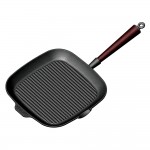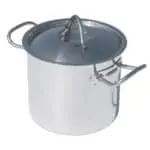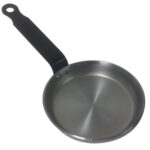Here we will try to guide and inspire you to choose the right knife, pan, pot or baking mould, which is not always the easiest.
Knives
Pans & Pots
Bakeware
Material
1: How many knives do you need?
We think three really good knives are the foundation, but to cover all needs, five favorite knives of different types are a fair amount. Then you can cut, scale, chop or fillet anything else.
2: How to choose right?
Form: Today, knives are stamped or forged. Forged knives, you recognise that the blade is wedge shaped, that is, the blade’s back is significantly thicker than it is down to the edge. Forged knives also have a so-called middle egg and strong finger protection. Punched knives have thinner leaves and not as clear wedges. They also lack middle eggs.
3: Take care of the knives.
Good knives last for almost any time. If you take care of them correctly, they will be as beautiful to use year after year. There are two ways to keep the knife sharp. Something you can do almost every time you use the knife, is with a knot. Grinding on the other hand is only needed when the sharpening is no longer enough – when the knife feels slack. Sharpening is easy. Even maintenance grinding can be done by yourself with a knife slip for home use. But when that is not enough, you should leave them to professionals.
NOTE: Bread saws and other knives with toothed eggs can neither be burned nor sanded at home.
4: Angle of grinding.
It’s important to keep the knife right when you’re brewing. The angle of the bridge rod is what determines. European knives should be drawn 15-20 degrees to the bridge line. On Japanese knives there is a less steep grinding, therefore they should be browning at an angle of about 10 degrees. Once you find the angle, pull the knife’s egg against the stick with light hand a few times. Varies between the two sides of the egg.
5: How does the knife feel in the hand.
Cook knives should have space for fingers and knees under the handle when you have the edge of the cutting board.
6: Do not cut this.
Watch out for cutting into goods with or in frozen foods, which can damage the edge of the knife. This also applies to dishes, crockery, sink, or glass or marble cutting boards.
7: Storage.
Magnetic strips and knife blocks have two major advantages: you can easily see and choose the right knife, and the knives are good.
Knives lying loose in a box are hard to find, easily damaged and become dull as they shrink against each other.
8: Wash by hand.
The best way to cook knives is by hand. Just remember not to put them in the counter with cutlery and other items. It’s easy to cut! Do not clean your knives in any machine – it does not make the knife or machine good. Machine dishwashing agent contains abrasives that make the knife blow. The blade’s eggs easily damage the machine’s wire baskets, which are made of plastic-coated metal. If there is a hole in the plastic, the basket can start to rust and the dishes become stained.
9: Accessories.
A good broomstick is almost as important as the knife itself.
Knife block or magnetic stripe as well.
Appropriate cutting board, check what the professionals use.
10: Tips.
After chopping and cutting, do not scratch the cutting board with the knife’s egg.
Then it quickly gets worn. Instead, turn the knife and scrape with the blade’s back.
Here we help you choose the right product.
Saucepans:
It’s the kitchen work horse with its straight high sides and capable of well much more than the name suggests. A good sauce roll (or just a saucepan) can handle anything from boiling potatoes, grilling or poaching eggs. They have long and good handles for lifting.
Available in sizes from 0.7 to 3.1 liters (15-18cm) in highest European quality on stainless 18/10. Tips are the models with extra high sides (2.2 liters & 3.1 liters).
Click here to get to the pots.
Clay and Cast Iron Casseroles:
Casseroles are available in a variety of shapes, sizes and materials.
Round or oval with a handle on either side, can be used on the stove or in the oven. They are perfect for various pots (coq au vin, boeuf bourguignon, Creole casserole, etc.) or to braze the ingredients on low heat for a long time (long cooking).
Genuine casseroles are made of cast iron or earthenware – both ideal for a gentle warming and to maintain a stable temperature for a long period of time.
Click here to get to the casseroles.
Pots:
These are lighter pots than clay and cast iron, as they are made of stainless steel (18/10). Most commonly used to cook pasta, prepare sauces, garbage or reduce.
Available in several sizes from Höganäs Bruk.
Click here to get to the pots.
With sloping edges that allow food to slide easily from pan to plate, there should be generous surface for food to be cooked quickly. By using a little food fat, you dehydrate the food that gives it a nice crispy surface.Pans are available in a variety of materials, such as the traditional cast iron, the popular carbon steel or stainless steel. All without any kind of coating, as this is created naturally.Click here to get to the pans.

Grill Pans:
If you love a juicy steak, you’ll soon fall in love with a cast iron grinder. The cast iron grilles are intended to have an intense dry heat that will immediately brown the meat and keep the delicious juices and flavors inside the meatbone.
Click here to get to the grill pans.







